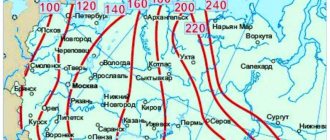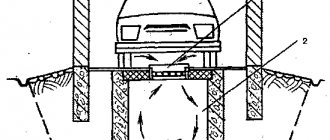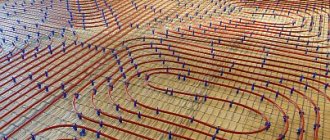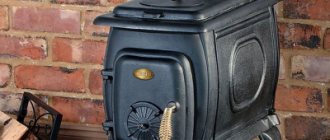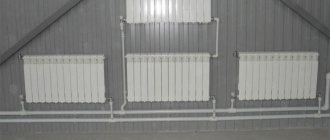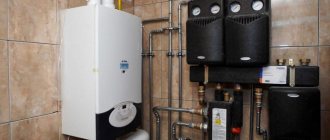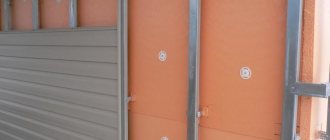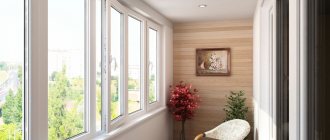A garage is a building designed for storage (parking) and maintenance of vehicles. Depending on the type of structure and the type of materials used for construction, the structure can be lightweight or capital, standing alone, or built into or attached to another building. The finishing options for such a room also differ. If it is of the capital type, then during the construction or operation of such a structure the floor in the garage is usually insulated.
Why is garage floor insulation done?
Work on floor insulation increases the financial costs of construction or repair of an operating facility, but nevertheless, these costs are justified, because Floor insulation allows you to achieve the following results:
- The ability to maintain indoor temperature within the specified parameters with minimal heat loss through the floor surface;
- Creating comfortable conditions when repairing various types of equipment and performing other work;
- Maintaining an indoor microclimate that will be optimal for storing equipment, spare parts and other materials.
Many users think about how to make a warm floor in a garage, and depending on the design of the floor, there may be several options for such arrangement.
Recipe for preparing the mixture
Before pouring concrete, you need to prepare a solution. The ingredients used are cement and sand in the following ratio: 1:3, 1:4 or 1:5. It depends on the brand of cement purchased. So, for example, if the cement is M400, then you choose a proportion of 1:3.
However, more and more often, when carrying out this type of work, the choice is made on dry mixes such as M150 (sand concrete). They are made using modern technologies, fiber fiber and plasticizers are added to the recipe, and this allows you to make a smooth and durable screed. Leveling mixtures are used as a face screed.
The thickness of the layer is two to three centimeters.
TAKE NOTE: When making the solution yourself, it will be handy to use a concrete mixer or at least a shield with a shovel.
The reinforcement will give the necessary rigidity and strength to the concrete surface.
Insulated floor design options
Insulation of the garage floor, depending on the materials used in its construction, can be done:
- For concrete floors using expanded clay, penoplex and other modern thermal insulation materials.
- For wooden floors using expanded clay or mineral wool.
Insulation of a concrete floor in a garage with expanded clay
Expanded clay is a fairly common and inexpensive material for floor insulation.
If expanded clay is used as a material providing insulation, then the sequence of work is as follows:
- In accordance with the perimeter of the garage, a pit is dug, 0.4 - 0.5 meters deep;
- The bottom of the pit is compacted and a drainage layer is laid, using coarse sand.
- Waterproofing (roofing felt or other similar material) is laid on the drainage layer.
It is important to remember that in order to ensure waterproofing of the floor, it is necessary to glue the strips of roofing material together and the places where it adjoins the elements of the foundation or walls!
- To create the plane of the installed floor, according to its required level, beacons are set, in accordance with which the insulation is backfilled.
- Expanded clay is leveled, its top layer is spilled with a liquid solution of sand and cement.
- A metal mesh is laid and secured.
- Concrete is poured in accordance with the required marks of the installed floor.
Advice from an expert: after pouring concrete, it is necessary to periodically wet it until it hardens completely, this will prevent the formation of cracks on the floor surface!
Insulation of a concrete floor with penoplex
Penoplex is a building material that has a gas-filled structure and is made from polystyrene.
Penoplex - a highly effective thermal insulator for floors
When using this material, insulation of a concrete floor in a garage is carried out as follows:
- The base is prepared, for this purpose the top layer of soil is removed to a depth of 5.0 - 10.0 cm, after which the prepared area is compacted.
- The beacons are set to the required floor level height.
- A rough screed up to 5.0 - 7.0 cm thick is poured onto the prepared base with cement mortar and time is given for it to harden.
- After the screed has hardened, waterproofing is laid over its surface. Roofing felt is used as this waterproofing layer. The joints of the sheets and the junctions with the garage foundation (walls) are glued.
- Penoplex is laid over a layer of roofing material. The sheets are glued together with special glue or foam.
- Another layer of waterproofing is laid. In this case, polyethylene is used, glued with tape.
- A reinforced mesh is placed on top of the second layer of waterproofing, which is attached to the load-bearing building structures.
- A concrete floor is poured along previously installed beacons.
Insulation of a wooden floor with expanded clay
Due to the fact that expanded clay has a number of advantages and is a relatively inexpensive building material, it is often used for insulating garages when the floors are made of wood. In this case, the work is carried out similarly to the option with a concrete floor, but there are a number of differences that affect the process of work.
Expanded clay is poured into the space between wooden joists
Floor insulation is performed in the following sequence:
- A pit is dug, and its depth must correspond to the sum of the thickness of the rough screed, the joists on which the floor boards are laid and the thickness of these boards.
- The base of the pit is compacted and preparation (rough screed) is poured over its area.
- A layer of waterproofing is laid. For this, roofing felt is used, the joints of the sheets and the junctions with the walls and foundation are glued.
- Logs are laid over the waterproofing layer.
- Insulation is poured between the joists and aligned with the top mark of the joists.
- A wooden floor is laid.
Insulation of a wooden floor with mineral wool
Another material that can be used to insulate a wooden floor is mineral wool.
Mineral wool is less popular for floor insulation, but effective
This building material has the ability to absorb moisture, which can adversely affect the condition of the flooring.
It is very important to pay attention to the tightness of the waterproofing layers, ensuring that moisture cannot penetrate into the thermal insulation layer!
In this case, the work is performed as follows:
- The base is prepared, the soil is leveled and compacted.
- The floor level is marked in relation to the building structures.
- The concrete is prepared (rough screed).
- Waterproofing made of roofing felt or similar material is laid over the rough screed layer.
- The joints of roofing felt sheets and the junction points are sealed.
- The logs are being laid. The pitch of laying the logs must correspond to the width of the sheet or roll of mineral wool.
- Mineral wool is placed between the laid logs, and the joints between the sheets are sealed with tape or adhesive tape.
- A second layer of waterproofing is laid, for this purpose polyethylene is used, the parts of which are also connected to each other using adhesive tape or adhesive tape.
- A wooden floor is laid along the previously installed joists.
Implementation of waterproofing
To prevent water from approaching the concrete slab due to capillary rise, it is necessary to lay a special moisture-proof material.
Typically used as a waterproofing agent:
- Tol;
- Glass rubber;
- Folgoizol;
- Polyethylene film (250-300 microns);
- Hydroisol.
Regardless of the type of material you choose, it must be overlapped.
The required overlap is ten to fifteen centimeters. PolaRemont.ru also advises taping the joints with PVC tape or double-sided construction tape.
Some useful tips:
- Waterproofing is laid in an even layer over the surface of the sand layer;
- Try not to allow any creases;
- The canvases should “climb” onto the wall and remain at the height of the future floor;
- The waterproofing material is carefully folded in the corners. Under no circumstances should you cut it.
Why are overlaps needed? They provide the waterproofing agent with a decoupling between the walls and the poured concrete monolith, and will also create the necessary thermal compensation gap.
The sand is spilled with water - this way it will be evenly distributed and settled
Advantages and disadvantages of various materials used for floor insulation
Various materials that can be used to insulate a garage floor have their own inherent advantages and disadvantages, which determine the possibility and economic feasibility of their use.
Let's summarize the advantages and disadvantages of building materials in a table.
| dignity | flaws |
| Expanded clay | |
|
|
| Penoplex | |
|
|
| Mineral wool | |
|
|
Eliminating cracks
To insulate an existing garage floor with your own hands, you need to eliminate the cracks in the floor. There are two options: disassemble the surface and lay insulation underneath, or eliminate the gaps manually by pushing various insulating materials into the gaps with a screwdriver (or other convenient tool).
The modern building materials market offers the use of polyurethane foam to insulate hard-to-reach and narrow areas. Liquid foam expands very quickly, filling all voids with its volume. After hardening, the excess part is very easily cut off with a mounting knife. One cylinder will be enough to seal cracks in a floor area of up to 20 m2.
How to insulate a garage floor if you have a cellar
Often in the garage, in addition to the fact that the vehicle is parked there, there is also a cellar in which vegetables and various preparations for the winter are stored. In this case, floor insulation work has some differences from those previously discussed.
The process of floor insulation itself, depending on the materials used, will be similar to the work options discussed above. The difference is that in order to achieve the required microclimate inside the garage, you will need to insulate and waterproof the walls and floor of the cellar itself.
Important: when constructing a cellar in the form of a caisson, no additional work is required!
Work on insulating the cellar is carried out during its construction. The materials used to perform this work may be the same as those used to insulate the garage floor. Particular attention is paid to waterproofing the walls of such premises and the junctions of various building elements.
The ceiling of the cellar is the floor of the garage, so the strength of this structure determines the service life and technical characteristics of the entire room. The most complex element of this design is the entrance to the cellar, which must also be thermally insulated and no cold bridges should form on its elements.
Useful tips
To insulate your garage floors as efficiently as possible, there are some important details you need to pay attention to. Very often, garage cooperatives build premises equipped with inspection pits. In this case, it is not enough to simply insulate the floor; you must also take care of an open source of cold.
The inspection hole is rarely used for its intended purpose. To minimize heat loss, garage owners make plugs and insulate them with available materials. If the thermal insulation of the floor and the pit is different, there is a high probability of additional condensation in places where there is a temperature difference.
Important! The thickness of the insulation of the inspection hole plug must be the same as the thickness of the material used in the concrete screed.
If there is a basement in the garage, it is imperative to additionally insulate the partition between it and the main room. In order not to reduce the height of the ceilings, you can insulate the partition from the bottom side. Sheets of expanded polystyrene or other insulation are attached to the basement ceiling and secured with boards or metal profiles.
How to insulate a garage from the outside - step-by-step instructions
For external work, it is most convenient to use rigid slabs. The cheapest option is polystyrene foam. PENOPLEX is more expensive, but much more effective in terms of moisture resistance, heat protection, service life and strength. Therefore, we will consider the installation procedure for this particular material. However, it is almost no different from the foam insulation technology.
We will need:
- glue (branded PENOPLEX is best, since its composition is specially adapted for this insulation and does not destroy it);
- a spatula for applying glue or a special gun;
- paint knife or jigsaw for cutting sheets;
- fastening disc elements (4 pieces for each plate).
Step 1.
We prepare the walls.
We clean them of old paint, dirt, dust, cobwebs and other things. You can use a primer to help the glue adhere better. But this is an optional point.
Step 2.
We fix the bottom bar.
It is typical for slabs to start installation from the ground. We attach the starting profile to the dowels and begin laying the material in a checkerboard pattern.
Step 3.
Insulation fasteners.
This is a simple matter: apply glue in strips to the slab and apply it to the wall. We connect the L-shaped grooves to each other, thereby ensuring a tight fit of the material without gaps. When the glue dries, for greater reliability we fix the sheet with disc-shaped dowels.
Step 4.
Final works.
To protect PENOPLEX from ultraviolet radiation and make the facade more aesthetically pleasing, we plaster the walls or cover them with siding, DSP, or other material.
Walls
We start, similar to the ceiling, with waterproofing. At a distance of approximately 60 cm from the floor, frame beams are installed to attach the insulation, but you can use a simplified version by placing the insulation on glue or attaching it to the wall with self-tapping screws.
Insulation is laid between the beams if you still choose this type of fastening. The next stage is attaching the vapor barrier film with staples and covering the walls with any material desired.
An important point: before starting facing work, seal with sealant or foam all the cracks and inconsistencies left after attaching the insulation. The exception is ventilation.
PENOPLEX (extruded polystyrene foam)
Perhaps, for insulating a garage from the inside with your own hands, this is the best option. It is affordable and even easier to install than foam plastic - the joints do not need to be sealed with foam, because they have L-shaped grooves. It is easy to cut and can be glued directly to the wall.
But the most important thing, of course, is its thermal insulation ability - one of the best among modern materials. Moreover, it remains unchanged in any situation. PENOPLEX does not get wet (moisture absorption coefficient is less than 0.4% in 28 days), is not afraid of defrost-freeze cycles and lasts for more than 50 years.
It is resistant to compression, does not shrink, absorbs noise, does not rot, does not harbor insects, and to top it all off, it is a homogeneous mass of polymer without individual granules. This provides it with high strength even many years after the work has been carried out.
Summarizing all of the above, we conclude that this material is ideal for both external and internal insulation.
Choice of insulation
Popular floor insulation options:
- Expanded clay is a popular bulk heat-insulating material with moisture- and fire-resistant properties;
- Affordable and easy to use foam boards with a long service life;
- Expanded polystyrene, characterized by excellent moisture resistance and thermal conductivity;
- Mineral wool in the form of slabs is suitable for insulating wooden floors. Requires vapor barrier and ventilation;
- Granulated slag, which is a by-product of iron smelting. Its advantages are thermal insulation properties. The disadvantage is toxic combustion products. In order for them to weather, you need to keep the material in the fresh air for about two years.
Overview of the thermal insulation materials market
Before moving on to the process of insulating a garage structure, let’s talk about insulation materials. About those that are used today for this purpose. There is a fairly large layer of building materials of this type that builders use today. There are traditional materials here, and others that have appeared recently, but have already gained popularity.
Mineral wool
This insulation has been used in construction for a long time. At the very beginning of its appearance, it was a roll-type material. Today it is still produced in this design, but the modern form of mineral wool is slabs. They are called mineral wool slabs.
Mineral wool boards are a popular insulation materialSource 2gis.kz
The only drawback of mineral wool is its hygroscopicity. That is, this material absorbs moisture well, while losing its thermal characteristics. To prevent this from happening, the heat-insulating layer is covered with waterproofing films on both sides. Today, manufacturers offer moisture-resistant mineral wool slabs, in which hygroscopicity is reduced to the maximum. This makes it possible to refuse waterproofing.
So for mineral wool this characteristic is 0.035-0.04 W/m K.
Expanded polystyrene boards
Many people call this material foam plastic, which is fundamentally wrong, although both materials are included in the group of foamed plastics made from polystyrene. It’s just polystyrene foam – a material originally created for packaging. It has low density and low thermal insulation qualities. The same cannot be said about expanded polystyrene, which was originally developed as a thermal insulation material.
Moisture-resistant polystyrene foam boardsSource www.stroyportal.ru
This foam insulation has serious advantages:
- thermal conductivity – 0.028-0.034 W/m K;
- the extruded version does not absorb moisture;
- passes air through itself;
- strength – 1 kg/cm²;
- inert to many chemicals;
- mold and fungi do not live on the surface of the insulation;
- it is a good sound insulator;
- service life – 30 years.
But polystyrene foam boards also have their drawbacks. And the most important of them is fire hazard. The insulation burns well and maintains combustion, while emitting acrid smoke. Today, manufacturers are trying to change the situation with this indicator. Fire-resistant boards have already appeared on the market, but there are not many of them.
Expanded polystyrene boards brand PSB-S-35Source karkasdomproekt.ru
Polyurethane foam
This is a two-component material, the ingredients of which are mixed before application. In terms of its physical state, it is a foamed semi-liquid mass that hardens in air, forming a hydrophobic layer on the insulated surface. That is, not afraid of moisture.
This is a non-flammable insulation. Service life – 50 years. Thermal conductivity – 0.019-0.028 W/m K. moisture absorption is minimal – 1.2%.
Layer of applied polyurethane foamSource foamshop.ru
Warm plaster
This plaster solution got its name because manufacturers add particles of heat-insulating material to its composition. These can be polystyrene foam granules, so-called crumbs, vermiculite (foamed rock of volcanic origin), sawdust and other ingredients.
Warm plaster is applied to the wall in a thick layer. Source tk101.ru
So, we have looked at the main thermal insulation materials that are most often used today when insulating a garage building. Of course, this is not the entire list of proposed options. They just use these more often.
| Insulation | Mineral wool boards | Expanded polystyrene boards | Polyurethane foam | Warm plaster |
| Price | 13-20 rub. for 1 m² | 15-50 rub. for 1 m² | 1200-1500 rub. for 1 m² | 350-750 rub. for 1 m² |
The price range for each material is quite wide. This is explained by the fact that the basis for pricing is the thickness of the insulation and its density. The table shows that the most inexpensive option is mineral wool and polystyrene foam boards.
The most economical thermal insulation materialsSource krysha-expert.ru
Gaps and screed slope
When installing a concrete floor, you should never forget about such an important condition as the slope. Only two percent is acceptable, i.e. two centimeters per square meter. The slope of the screed should lead towards the drain grate or gate.
Compensation gaps should not be neglected either. They are needed near internal protruding parts (pipes, pillars, ledges, etc.) and all walls. This condition is mandatory when the garage area does not exceed fifty square meters. It is most convenient to leave gaps while screeding. To work, you need to stock up on a strip of polystyrene foam (half a centimeter thick), expansion tape or a plastic profile made of the same material.
Installing a layer of thermal insulation
Not every mountain is heated during the cold season. Often such a room is not classified as heated. At the same time, the need to perform work, for example, in winter does not disappear. And you have to repair or upgrade your car even at sub-zero temperatures. To avoid unnecessary energy costs, you can insulate the floor. The main thing is to do this at the stage of working on the concrete surface in the garage.
As experts note, you can save 20% of the energy spent on heating.
The main thing is to lay the insulation before the concrete is poured. Most often, high-density extruded polystyrene foam is used as a heat insulator.
The thickness of its panels is eight to twelve centimeters. The material was specially developed for such purposes.
When laying insulation, you don’t have to worry about overlap. Just fit the material elements tightly together. Again, use construction tape to tape and secure the seams. Expanded polystyrene must be covered with plastic film. Only after this will it be possible to calmly begin pouring the main mass.
Rescue ventilation
The first step to defeating condensation and corrosion is installing ventilation in the garage. In opposite corners of the garage, two pipes must be brought out.
We will place the lower edge of one of them closer to the floor. Cold air will flow into the room through this pipe. A short pipe near the ceiling in the other corner will serve as a hood.
This simple but reliable device will work automatically without failure, creating natural movement (convection) of air throughout the garage without fancy fans.
Convection will prevent condensation from forming. Wet fumes will simply fly out into the chimney. Exhaust gases hazardous to health, evaporation of fuel, and other chemicals stored in the garage will also be directed there.
Now let’s move on to the most important thing - insulating the garage with our own hands. Here the situation is more complicated, but the task is quite accessible for independent solution
General principles
Let's start with some useful general tips.
When choosing insulation and heating methods, it is worth remembering SNiP 21-02-99 “Car Parking”, according to which the recommended temperature for a garage is +5C. The warmer it is inside the garage, the more moisture will condense on the surface of the body of a car that has driven into it from the cold, and the faster the body will rot.
However, there is a simple and cheap solution - to cover a concrete floor without joists with boards of any thickness. The floor will become noticeably warmer; Cleaning under the flooring or replacing a rotten board will also not be a problem.
A simple boardwalk over concrete is a very simple and fairly effective insulation.
- Of the popular and affordable wood species, the ideal choice for flooring is larch. It does not rot even in damp conditions.
- A reasonable minimum thickness of the screed on top of the insulation is 100 millimeters. The screed is poured with a minimal slope towards the garage door: in this case, we will ensure normal water flow when washing the car.
- Reinforcement is carried out with a mesh with a thickness of 5 millimeters or reinforcement with a diameter of 8 millimeters. The price of mesh is slightly higher compared to reinforcement; however, in this case we get rid of the time spent on knitting reinforcement. Cell size is 15-20 centimeters.
- Under the screed, as in any other case, insulation that is not prone to deformation is laid. In the case of a garage, the instructions are especially important: as already said, the weight of the car is very significant compared to the load in residential premises.
- For obvious reasons, hygroscopic insulation materials are reliably waterproofed at the top and bottom. However, it is better to refrain from using them altogether: it is almost impossible to completely prevent water from getting into the thickness of the mineral wool on the floor.
Mineral wool is suitable for insulating walls, but on the floor it is almost impossible to protect it from moisture.
